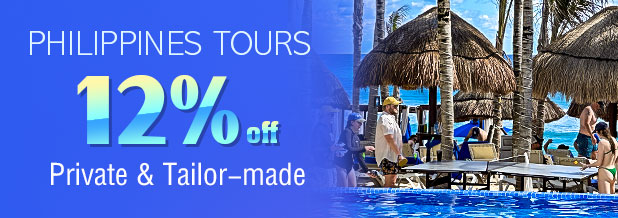- Top Things to Do
- Transportation
- Travel Tips
Top Things to Do in Philippines
Top Destinations
Manila
Manila is the capital as well as the largest city in Philippines, which is known as "the New York of Asia". Manila is a beautiful city composing many places of interest, such as St. Agustin Church, Manila Cathedral, Intramuros, and Fort Santiago.
Boracay
Boracay, located in northwest of Panay Island, is an island in the shape of a dumbbell in central Philippines. The island is 7km (4.35 miles) long and the white sandy beach, known as the finest beach in the world, is 4km (2.48 miles) long. You can enjoy diving and surfing. In Boracay, you cannot miss White Beach, Puka Beach, Friday Beach and Willy's Rock.Cebu
Cebu, located along the north coast of Cebu Island, was first discovered by the famous Portuguese explorer Magellan in 1521 and hailed as "Queen City of the South". It is the second largest city in Philippines with a highly developed business and industry center and a main international flight hub. You can visit Basilica Minore del Santo Nino to know the history of Cebu, appreciate the murals drawn on the ceiling over Magellan's Cross, enjoy the oldest Fort San Pedro in Philippines, and play with butterflies in Butterfly Sanctuary.
Dumaguete
Dumaguete lies in Negros Island, the fifth largest island in Philippines. Apart from Silliman University, the oldest American-style university in Asia, there are many universities and colleges, thus it is called "University City". Due to the warm and clean water, Dumaguete has the most unique and beautiful marine life in the world with more than 3,000 species of fish and 448 species of corals. You can wander in Silliman University and explore Silliman University Anthropology Museum, visit the landmark building Dumaguete Belfry, and show your respect to St Catherine of Alexandria Cathedral which is the miniature of Philippines' history.
Top Attractions
1. St. Agustin Church
Many Catholic Churches scatter over the country, known as the "Vatican of the East". St. Agustin Church was founded in 1571 with a history of more than 400 years and was inscribed on the UNESCO list in 1993. It was originally built with bamboo, coconut palm and clay, but was destroyed by fire, and was rebuilt with stone in 1599. St. Agustin Church is the oldest stone church in Philippines and survived in five earthquakes and two world wars, so it is considered to be a miracle.St. Agustin Church is featured with delicate and vivid stone reliefs. There are paintings on the ceilings and walls, and the statues of Agustin and Jesus are in the center of the church. Top-ranked Philippine officials are buried in the church, and the floor is engraved with their information.
2. White Beach
White Beach is the largest reason why Boracay can be famous at home and abroad. It is located in the middle of Boracay, formed by grinding corals, and measures 4km (2.48 miles) from south to north. It is rated among the world's top ten beaches and honored as the most beautiful beach in Asia which has gentle slope, delicate white sand, and crystal sea water. The sunset is very charming and the sky is connected with the sea under a flaming sunset.In a sunny midday, it is still cool walking in the sand; in the evening, White Beach turns to a huge bar decorated by lights and music. You can take part in water activities such as snorkeling, diving, windsurfing, parasailing, and rowing banana boats and glass bottom boats. You'd better bargain with the locals to get a reasonable price.
3. Basilica Minore del Santo Nino
Founded in 1565, it is known as Santo Nino. It is said that the black-skinned Santo Nino was a gift sent to Rajah Humabon and Queen Juana after they were baptized. In 1565, Cebu was burned to the ground on April 27, but the Santo Nino was intact and was then worshiped by locals as a miracle. Subsequently, Captain Miguel Lopez de Legaspi and Fr. Andres Urdaneta built "the Basilica Minore del Santo Nino" at the site where Santo Nino was found. Copies of Santo Nino were placed in the convent of Catholic Cathedral. The original Santo Nino is kept in the altar. The 40-centimeter wooden Santo Nino is revered as the oldest icon in the Philippines and is still warmly worshiped by the public today.
4. Silliman University Anthropology Museum
If you are interested in anthropology, you must visit Silliman University Anthropology Museum. In this museum, you can learn about the Anthropology exhibits of Philippines and ethnography relics most of which are more than one thousand years old. Besides, you can also look around Silliman University.Best Souvenirs
Philippines is rich in wood carving handicrafts, such as woodcuts, puppets, jewelry boxes and chessboards, guitars, as well as bamboo, coral, and coconut shell products. Shell handicrafts are also popular in Philippine, such as shell necklaces, brooches, lampshades, mural decorations, tea-cup cushions, and containers. You may also like a variety of handbags, rugs and balls made from Manila hemp. Dried fruit is very popular among visitors, such as dried papaya, mango and pineapple.
Further Reading:
Philippines Transportation Useful Travel Tips

